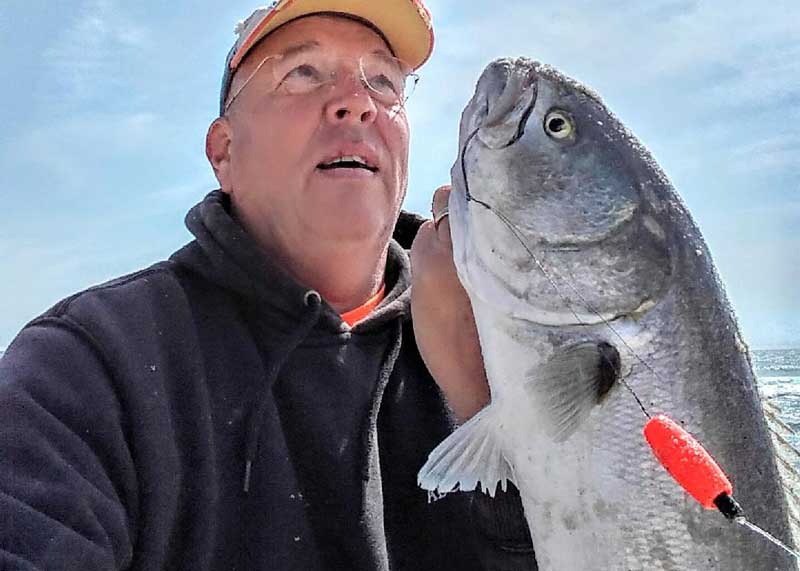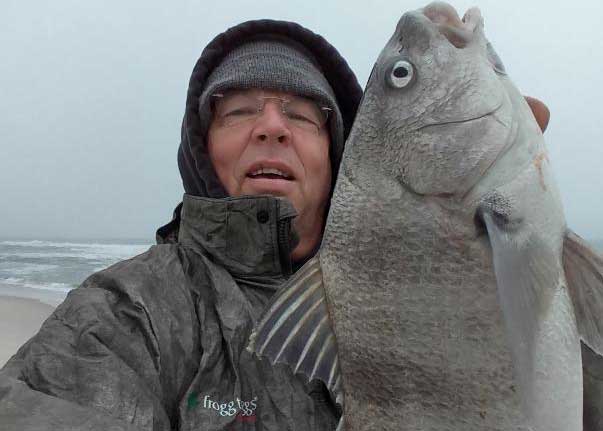This spring, somewhere between the last week of April and first week of May, long, lean, hungry schools of blues averaging eight to 10 pounds should once again invade Delmarva and especially Assateague Island to terrorize everything swimming in the surf - bluefish are near the top of the list when it comes to aggression. But just before they appear the black drum run will likely begin to kick the action off. Before we dig into the details, check out this video on how to catch drum in the surf, filmed in mid-April last year.
More about drum in a moment, but for now, let's talk blueish!

Bluefish may be one of nature’s perfect predatorial gamefish. They are hungry, roam just about everywhere there is saltwater, and can be found from the surf out to the deep. I’ve actually caught them on bottom while fishing for golden tiles in 800 feet of water. The mere fact that bluefish feed down there tells us about their tolerance for chilly temperatures and explains why they are one of the first species that move north and become available to early season surf fishermen. While most say bluefish prefer 68-degrees, I’ll be on the beach when water temps reach the upper 50’s. By the time surf reaches 68 degrees, the “gator” or “chopper” blues – the biggest of the spring – will have pushed further north. Right behind the big boys will be the two to five pound “Taylor” blues, and finally the small snappers arrive, and then hang around all summer in the surf.
Excellent eyesight and aggressive feeding allows blues to be caught on just about any artificial lure thrown in their path. However, it is advised to stay away from casting bucktails, because those razor-sharp teeth cut the hair off in short order leaving you with what only can be described as a very ugly lure. Metal lures such as diamond jigs or Hopkins are better choices when walking the beach and casting. Any type of surface popper will grab their attention as well. But by sticking to metal, longer casts can be made when a school is observed tearing into baitfish near the outer bar. However, don’t think long cast are always necessary. Often during a bluefish blitz, baitfish are literally chased right up onto the beach.
After choosing your weapon swap out the treble hooks and replace them with a single J-hook; it simplifies removing the hook from that set of rather dangerous teeth. It’s also advisable to use a short piece of wire leader if you want to avoid running back to the tackle store after every outing, because those big blues have a real talent for biting your lure off.
Of course, soaking bait is also a productive and popular surf fishing tactic. What kind of bait? When bluefish are feeding, it doesn’t make much of a difference. Although, keep in mind the number-one rule when it comes to bait: fresh is best. Fresh Menhaden is available at most tackle shops and is a popular cut bait, but any type of fresh-cut fish gets the rods bent. Cut it into chunks that fit an 8/0 or 9/0 hook rigged on a piece of wire leader with three-way swivel and enough weight to hold bottom. Squid is another good bait. Thaw and use a whole squid on the hook. Frozen finger mullet fished whole is also great, but hook size may need to be downsized to match.
Blues have excellent eyesight and no one will convince me that a bright-colored float near the hook does not increase catches. I’m partial to red, orange, and yellow; bluefish seem to be as well. The rods with floats always seem to out-fish rods with plain rigs.

Why wouldn’t I use floats on all the rods, you ask? Good question! It’s because bluefish are not the only species I’m looking for, when soaking bait in the spring surf. There’s another early season invader looking for a meal, and that’s the black drum. The past few years they have made a good showing and have been worth targeting. But they’re a bottom feeder, so bait should be fished on the bottom with no float. And unlike the bluefish, black drum are picky eaters. Clams, peeler crab, soft crabs (hmmm… why anyone would use a fresh soft crab as bait instead of between two pieces of bread with mayo, lettuce, and a sprinkling of Old Bay seasoning is beyond me), and sand fleas are the baits of choice. The good news is that bluefish like these baits as well – yes, even the sand fleas. Keep in mind, however, that during spring as the surf washes back off the beach you won’t see those colonies of sand fleas giving their location away, as they do during the summer months (read Surf Fishing How To to learn more about locating sand fleas during summer). In spring with cold ocean temps, dig down about six to eight inches at the top of the wash, to locate those fleas. Personally, I think fresh clams are the best bait. Fish the clam whole and be sure to insert hook through the hard orange-colored section known as the foot. Use caution casting out. Don’t throw hard, but instead, lob the rig out to prevent throwing off the bait. Don’t worry about distance, because often the drum are right in the slough close to beach searching for breakfast, lunch, or dinner.
What’s the best tide or time to fish for spring blues and drum? Whenever you’re not working! High tide, low tide, rain, sun, warm, cold, wind, or beautiful calm spring day can all be productive – and you just never know when a school of blues will blitz the beach. See you on Assateague!
- By John Unkart, author of “Offshore Pursuit” and “Saltwater Tales,” available on Amazon.